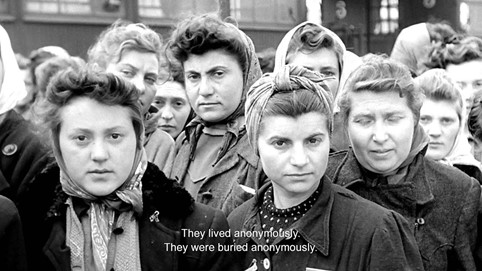Excavating a lost history of women (Nelly and Nadine)


Archive footage Magnus Gertten used in both Every Face Has a Name (2005) and Nelly and Nadine (2022).
The opening tracking shot portrays the arrival of women to Malmö who survived German concentration camps during WW2. This moment of liberation and how it was shot compels us to remember Jean Luc Godard's famous statement during a round-table discussion about Hiroshima, Mon Amour (1959): ”Tracking shots are a question of morality”. While Godard points at the connection between film form and ethics, Nelly and Nadine's opening sequence with this archive footage searches for an appropriate form to represent the Unrepresentable. Tracking shots are a question of morality – especially when it is about war, because these sliding images of faces can easily turn into a spectacle of atrocity and agitating portraits of victims, blended with some sense of pleasure. However, we see the director writing their names on the images to personify these women with mixed feelings of relief and grief, broken and hopeful. After naming some survivors, the film close-ups their faces looking into the camera as they are looking at us. Not only does subverting the convention of tracking shot that make a spectacle out of its object, but the film also reverses the traditional film-viewer relationship by giving subjectivity to these women whose gaze is onto us now. We imagine each of these women's stories with this subtle technique instead of consuming them as any other archive footage from an incomprehensible horrific past.
In the interviews, Magnus Gertten states that he did not want to make another film about WW2 since it is well told, but eventually, he could not resist the story of Nelly and Nadine. The director was intrigued by the element of love in this story as a romantic person, which differed his film from many WWII documentaries. Nelly and Nadine can be fairly considered as an LGBTQ+ film and even a documentary about feminist history. This layer of the film excavates a lost history of intellectual women in the early 20th century from a remaining trace of it, Nadine. Under the surface of Nelly and Nadine's love story, we are introduced to the back-then-famous literary salon Academie Des Femmes, founded by Nathalie Barney at 20 Rue Jacob. As literary biographer Joan Schenkar in the film puts it, this salon hosted female artists, writers and intellectuals for decades when Academie Française did not accept women until 1980. Schenkar resents Sylvie for why it took so long for her to investigate her grandmother's past and addresses the importance of it as ”Nothing is real, socially, until it is told”. This sentence resonates on both levels: documenting a concentration camp survivor's past, giving a name to a face to acknowledge her trauma as a part of history, and acknowledging women's movement and LGBTQ+ existence in the early 20th century, as well as their experience of war. Thus Gertten ”unlocks the secrets of this archive footage” and reveals an important piece of feminist history.
Nelly's heritage is also a late coming up. Sylvie opened up boxes full of WWII memories and secrets. Sylvie's hesitation to chase this story does not derive from the horrors of war only, but it is also about what Joan Schenkar asks her explicitly: ”It never occurred to you that these two ladies might be in love?” This family secret remained in the boxes in the attic as something bothered them for not facing it. Sadly, it is still challenging for the LGBTQ+ community to live their lives openly like Nelly and Nadine. Many people still hide their identities and/or live double lives. Expressing it is crucial so it can be (socially) real. Sylvie's journey seems to heal a generational wound. Especially after talking to Maria Lovera, who discovers her father's double life as well, Sylvie seems to appreciate the love between these two strong women and their admirable bond. Sylvie becomes ensured that her grandmother filled her life with love over the loss and grief that she experienced during WWII. The documentary highlights the differences between black and white photographs of the camps and coloured 16mm footage in which Nelly and Nadine have dinner parties with friends, chat, have lots of laughter, and peacefully live in their home. The indescribable admiration Jose Lovera tries to utter seems to be about finding love and companionship when the world crumbled on them and yet created a world for themselves, a safe space for anyone who could not live their lives openly.
The viewer might still see Nadine as a mystery. While searching for Nadine, we find Nelly, which might be a detour for some. Nelly and Nadine is a film that seeks an ethical approach to making a film about WWII. It is a film that transforms its protagonist on her journey and reminds us of our deficient gaze. It points at another aspect of the era, often not uttered much, without creating the pleasure of viewing the horrors of the war and without creating a pathetic victim out of it. It neither tries to represent the Unrepresentable nor attempts to state that a traumatic past is impossible to represent. Instead, the film reminds us of the impossibility of thoroughly comprehending the trauma and claiming to know it all. In other words, the film does not provide the viewer with a position of ”have seen all”, but it can only provide a point of view that will leave the story incomplete. The love between Nelly and Nadine is represented enough for those who are open to being affected by their Otherness and to those accept the deficiency of the gaze. The missing pieces in the story might be fairly considered as the director's ethical approach to the subject: the film's openness to its subject, our proximity to their relationship as much as it is allowed, and last but not least, its visible transforming effect on Sylvie.
Tataroglu Zelal
ELTE BTK Film Studies MA